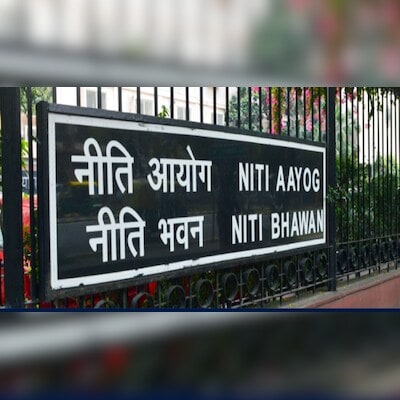The ninth Governing Council Meeting of NITI Aayog, chaired by Prime Minister Narendra Modi, is set to take place on Saturday. Amid calls of boycott from the Opposition leaders over their disappointment with Budget 2024, the meeting’s primary focus will be on the Approach Paper for the Vision Document on ‘Viksit Bharat @2047’, which aspires to make India a developed nation by 2047, the 100th year of its independence.
This vision encompasses economic growth, social progress, environmental sustainability, and good governance, the government said in a press release. Furthermore, the meeting will aim to foster ‘participative governance and enhance collaboration between the Centre and state governments’ to improve the quality of life for both rural and urban populations by strengthening the delivery mechanisms of government interventions, it added.
Goals of 2024 NITI Aayog meeting
The meeting will deliberate on the role of states in achieving the goal of ‘Viksit Bharat @2047’, recognising that a collaborative approach between the Centre and state governments is essential to realise this vision. Additionally, the meeting will focus on the recommendations of the 3rd National Conference of Chief Secretaries held in December 2023, which covered key themes such as drinking water, electricity, health, schooling, and land and property accessibility.
The Governing Council, comprising chief ministers of all states and Union Territories with legislatures and Lt Governors of other Union Territories, provides a platform to discuss inter-sectoral, inter-departmental, and federal issues to accelerate the implementation of the national development agenda.
A significant objective of the meeting is to create a roadmap for the ‘Viksit Bharat’ vision, fostering teamwork between the Centre and the states as ‘Team India’. India aspires to become a $30 trillion economy by 2047, and this meeting will aim to lay down the groundwork for achieving this ambitious target.
Several chief ministers to boycott the meeting
Many INDIA bloc chief ministers, including Tamil Nadu CM MK Stalin of the DMK, Kerala Chief Minister and CPI (M) leader Pinarayi Vijayan, Punjab CM Bhagwant Mann of the Aam Aadmi Party, and all three Congress chief ministers—Karnataka’s Siddaramaiah, Himachal Pradesh’s Sukhvinder Singh Sukhu, and Telangana’s Revanth Reddy—have decided to boycott the meeting.
They criticised the Centre for a biased Budget that allegedly favoured the NDA’s Bihar and Andhra Pradesh allies. Stalin said that the Budget presented by the finance minister seemed like a ‘vengeful act’ against the states and people who boycotted the BJP, accusing the government of continuously disregarding Tamil Nadu.
In contrast, West Bengal Chief Minister Mamata Banerjee chose to attend the meeting, intending to use the opportunity to protest against what she termed a “discriminatory budget” and the “conspiracy to divide West Bengal and other opposition-ruled states”.
Banerjee, along with Jharkhand Chief Minister Hemant Soren, plan to participate in the meeting to voice their concerns, despite opposition from the Congress and part of the JMM-led coalition government in Jharkhand.
However, Banerjee criticised the NITI Aayog, advocating for the restoration of the Planning Commission, claiming that NITI Aayog lacked financial power and effectiveness.
Meanwhile, BJP leaders criticised the opposition for boycotting the meeting, accusing them of undermining co-operative federalism and acting irresponsibly. Bihar Chief Minister Nitish Kumar, an NDA ally, had not yet confirmed his attendance.
What were the key outcomes of the 8th NITI Aayog meeting?
In the 8th Governing Council Meeting of NITI Aayog, chaired by Prime Minister Narendra Modi on May 27, 2023, the council deliberated on eight prominent themes, including Viksit Bharat @2047, support for Micro, Small, and Medium Enterprises (MSMEs), infrastructure and investments, minimising compliance burdens, women empowerment, health and nutrition, skill development, and Gati Shakti for area development and social infrastructure.
There was a strong emphasis on promoting Shree Anna, millet-based foods, in line with the International Year of Millets, as part of India’s nutritional strategy. The prime minister highlighted the importance of water conservation, particularly through the Amrit Sarovar programme, aimed at creating water bodies and enhancing water availability.
The meeting highlighted the necessity for states to maintain fiscal discipline and to utilise the Gati Shakti Portal for enhancing infrastructure and local development. Chief Ministers and Lt. Governors presented various policy suggestions, focusing on green strategies, tourism, urban planning, and agriculture, which NITI Aayog will consider for future planning.
Additionally, the meeting served as a platform to discuss the opportuNities presented by India’s G20 Presidency, which could enhance global exposure for the States.
What is the NITI Aayog Governing Council?
NITI Aayog, established on January 1, 2015, replaced the Planning Commission of India and aims to foster co-operative federalism through its Governing Council, which includes chief ministers and Lieutenant Governors of Union Territories. The Governing Council serves as a platform for discussing national priorities and strategies, facilitating collaboration between the Centre and the states.
The first meeting of the NITI Aayog Governing Council, chaired by Prime Minister Narendra Modi on February 8, 2015, set the tone for the organisation’s objectives, emphasising a new approach to economic planning.
Subsequent meetings, before the 8th meeting on May 27, 2023, focused on themes such as poverty alleviation, employment, and structural reforms in agriculture. The eighth meeting emphasised the vision for a developed India by 2047, discussed initiatives like the Aspirational Districts Programme, and highlighted the need for co-operative strategies among states to achieve national goals.
